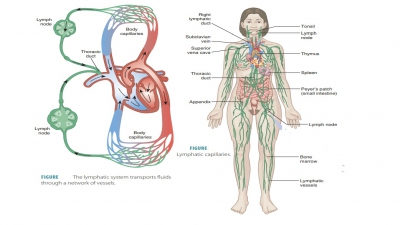Summary
| Home | | Anatomy and Physiology | | Anatomy and Physiology Health Education (APHE) |Chapter: Anatomy and Physiology for Health Professionals: Vascular System
The vascular system of the human body is made up of the systemic and pulmonary circuits.
Summary
The vascular system of the human body is made up of the
systemic and pulmonary circuits. The five general classes of blood vessels
include the arteries, arterioles, capillaries, venules, and veins. The walls of
arteries con-sist of three distinct layers and a blood-containing space known
as the lumen. In arteries and arterioles, vasomo-tor fibers receive impulses to
contract and reduce blood vessel diameter, which is called vasoconstriction.
When inhibited the muscle fibers relax, and the vessel’s diam-eter increases,
which is called vasodilation. The arterial system consists of the aorta and
pulmonary arteries.
The smallest diameter blood vessels are capillar-ies, which
connect the smallest arterioles to the small-est venules. Capillaries form
interwoven networks called capillary beds or plexuses. The formation of new
blood vessels, either in the embryo or when the body cells are oxygen-starved,
is called angiogenesis. Venules are microscopic vessels that link capillaries
to veins, which carry blood back to the atria. Vein walls are similar but not
identical to arteries but have poorly developed middle layers. Many veins have
flap-like valves projecting inward from their linings, prevent-ing blood from
flowing backward. Veins often act as blood reservoirs. Vascular anastomoses
are intercon-nections formed by blood vessels.
The blood must continue to circulate to sustain life, with
the heart acting as the circulation pump. Blood pressure is calculated by
multiplying cardiac output by peripheral resistance. It is the pressure exerted
by the blood’s circulating volume on the walls of the arteries, veins, and
heart chambers. The maxi-mum pressure during ventricular contraction is called
the systolic pressure. The lowest pressure that remains in the arteries before
the next ventricular contraction is called the diastolic pressure. The venous
blood pres-sure is steady and regular and does not pulsate with ventricular
contractions like the arterial blood pres-sure. Blood volume is the sum of formed
elements and plasma volumes in the vascular system.
Most neural controls of blood vessels operate because of
reflex arcs, which involve baroreceptors and related afferent fibers.
Baroreceptors are activated by increased arterial pressure. Chemoreceptors in
the aortic arch and large neck arteries send impulses to the cardioacceleratory
center to increase cardiac out-put. The brain stem’s medulla oblongata
integrates reflexes that maintain blood pressure. Short-term hormonal controls
involve ADH, angiotensin II, ANP, and the hormones of the adrenal medulla.
Long-term control of blood pressure involves the kidneys. Homeostatic
imbalances in blood pressure involve hypertension and hypotension.
Arteries are deep, whereas veins are either deep or
superficial. Veins have more interconnections than arteries. The aorta is the
body’s largest artery and emerges from the left ventricle of the heart. It
consists of four portions: the ascending aorta, aortic arch, descend-ing aorta,
and abdominal aorta. The head and neck are supplied by four paired arteries:
the common carotid arteries plus three branches from each subclavian artery.
The subclavian arteries branch to supply all portions of the upper limbs. The
abdominal aorta branches to form the abdominal arteries. The common iliac
arteries are divided into the internal and external iliac arteries.
Three major veins return blood from the body to the right
atrium: the coronary sinus, superior vena cava, and inferior vena cava. From
the head and neck three pairs of veins collect most of the draining blood: the
external jugular veins, internal jugular veins, and ver-tebral veins. The deep
upper limb veins and most of the pelvic and lower limb veins follow their
related arteries’ paths and therefore have the same names. The path-way of
blood flow from the gastrointestinal tract and spleen to the liver via the
portal vein and its tributaries is called the hepatic portal circulation. Aging
causes atherosclerosis in the blood vessels. Venous valves weaken and purple
varicose veins appear. Hyperten-sion is common, along with heart attacks, renal
failure, strokes, and vascular disease. Normal blood pressure is signified by a
reading of 120/80 or less, and hyperten-sion is signified by a reading of
140/90 or more.
Related Topics

